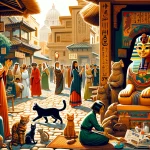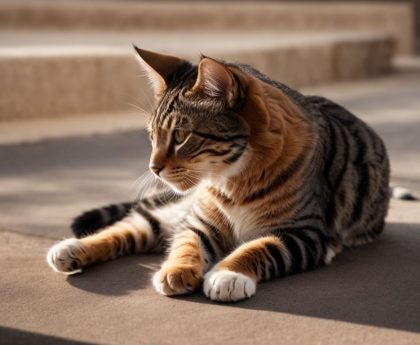The domestic cat, a creature that effortlessly straddles the line between wild independence and loving companionship, holds a unique place in the hearts and homes of millions around the globe. The journey of the domestic cat, from its origins in the wild to becoming one of the most beloved pets, is a fascinating tale of adaptation, survival, and the deepening bond between humans and felines. This article explores the evolutionary path of domestic cats, shedding light on their transformation and the pivotal moments that have made them the cherished companions they are today.
Wild Beginnings
Table of Contents
ToggleThe story of the domestic cat begins in the Near East around 9,000 years ago. The African wildcat (Felis silvestris lybica), a species remarkably similar in appearance to today’s domestic cats, is their closest ancestor. Initially, these wildcats were drawn to early human settlements by the abundance of prey, such as rodents, attracted by grain stores. This mutually beneficial relationship marked the beginning of their domestication process. Wildcats that were less timid and more tolerant of human presence had a survival advantage, gradually leading to a population of more docile felines that coexisted with humans.
The Path to Domestication
The domestication of cats was a slow and natural process, significantly different from the deliberate breeding practices associated with dogs. Cats essentially domesticated themselves, a testament to their independence and unique personality traits. Early farmers appreciated the natural pest control provided by these feline companions, and over time, cats began to assume a more prominent role in human societies.
As humans migrated and established civilizations, they brought cats along, facilitating the spread of domestic cats across the world. In ancient Egypt, cats were revered, associated with gods and goddesses, and kept as pets by families. They were admired for their hunting prowess and protective instincts, believed to bring good luck and ward off evil spirits.
Genetic Milestones
Recent genetic studies have shed light on the domestic cat’s evolution. A landmark study published in the journal Science traced the lineage of domestic cats to the Near Eastern and Egyptian populations of the African wildcat. This research highlighted how little domestic cats have changed from their wild ancestors, genetically and physically, compared to other domesticated animals.
One of the few significant changes has been in their social behavior. Domestic cats have developed a greater capacity for social flexibility, including forming attachments to humans and adapting to living in groups with other cats, which is not a common trait among solitary wildcats.
Modern-Day Companions
Today, domestic cats are found in a variety of breeds, each with its unique appearance and temperament. However, at their core, all domestic cats retain the essence of their wild ancestors, from their hunting instincts to their love for independence. The bond between cats and humans has deepened over millennia, with cats now playing a significant role in many people’s lives, not only as pets but as members of the family.
FAQ: The Evolution of Domestic Cats
Q1: When did cats first become domesticated?
A1: Cats are believed to have first become domesticated around 9,000 years ago in the Near East. The process began when wildcats were drawn to early human settlements by the abundance of prey attracted to grain stores.
Q2: Are domestic cats genetically similar to their wild ancestors?
A2: Yes, domestic cats are genetically very similar to their wild ancestors, particularly the African wildcat (Felis silvestris lybica). The main changes through domestication have been behavioral rather than physical.
Q3: How did cats spread around the world?
A3: Cats spread around the world by accompanying human migrations and settlements. They were highly valued for their natural pest control abilities and eventually became a common presence in various cultures and civilizations.
Q4: What role did cats play in ancient societies?
A4: In ancient societies, especially in Egypt, cats were revered and associated with gods and goddesses. They were kept as pets, believed to bring good luck, and were admired for their hunting skills and protective instincts.
Q5: How have domestic cats changed from their wild ancestors?
A5: While domestic cats remain genetically and physically similar to their wild ancestors, the most significant changes are seen in their social behavior. Domestic cats have developed the ability to form attachments to humans and adapt to living in groups, which contrasts with the solitary nature of wildcats.
Q6: Why are cats considered to have domesticated themselves?
A6: Cats are considered to have domesticated themselves because they initiated the process by being attracted to early human settlements for food. Unlike other domesticated animals, cats underwent a natural selection process where those more comfortable around humans had a survival advantage, leading to the docile felines we know today.
Q7: What genetic studies have been done on domestic cats?
A7: Genetic studies, including a significant one published in the journal Science, have traced the lineage of domestic cats to Near Eastern and Egyptian populations of the African wildcat. These studies have helped scientists understand the minimal genetic divergence between domestic cats and their wild counterparts.
Q8: Are there many different breeds of domestic cats?
A8: Yes, there are many different breeds of domestic cats, each with unique appearances and temperaments. Despite the variety of breeds, all domestic cats retain the essence of their wild ancestors to some degree.
Q9: How do cats communicate with humans?
A9: Cats communicate with humans through a combination of vocalizations, body language, and behavior. This can include meowing, purring, tail movements, ear positioning, and more, which convey their emotions and desires.
Q10: What is the future of domestic cat evolution?
A10: The future of domestic cat evolution is likely to continue focusing on behavioral adaptations, especially as cats live increasingly in urban environments and close proximity to humans. Genetic studies and breeding practices may also lead to changes in physical traits or health improvements in specific breeds.
Conclusion
The evolution of domestic cats is a testament to the power of natural selection and the unique relationship between humans and animals. From their wild origins to their status as beloved companions, cats have maintained their independence and mysterious allure. Understanding the evolutionary journey of these fascinating creatures enhances our appreciation of them, fostering a deeper connection between cats and their human companions. As we continue to learn more about their history and biology, we can better appreciate the depth and complexity of our feline friends, ensuring they remain cherished companions for generations to come.





